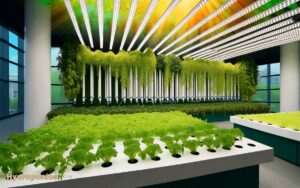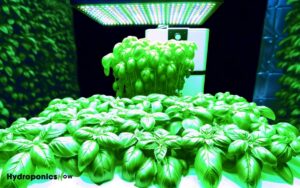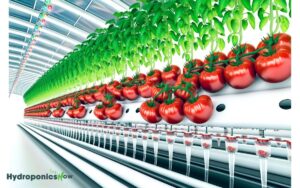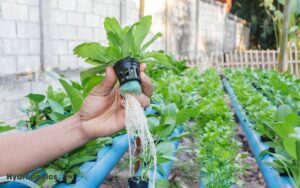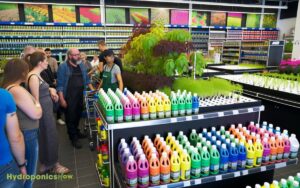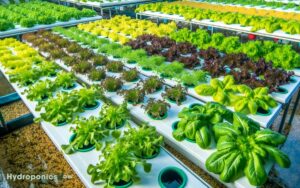Exploring 5 Different Types of Hydroponic Systems
Hydroponic systems encompass several sophisticated methods designed for efficient soilless cultivation. Among the passive options, Wick Systems and the Kratky Method cater to small-scale production and minimal maintenance.
Active systems like Deep Water Culture, Nutrient Film Technique, Ebb and Flow, and Drip Systems offer precise control over nutrient delivery and oxygenation for rapid plant growth.
Advanced systems such as Aeroponics, Aquaponics, and Vertical Hydroponics optimise water use, space, and yield, making them ideal for commercial and urban farming.
For a deeper grasp on the nuances and distinct advantages of each system, further exploration is encouraged.
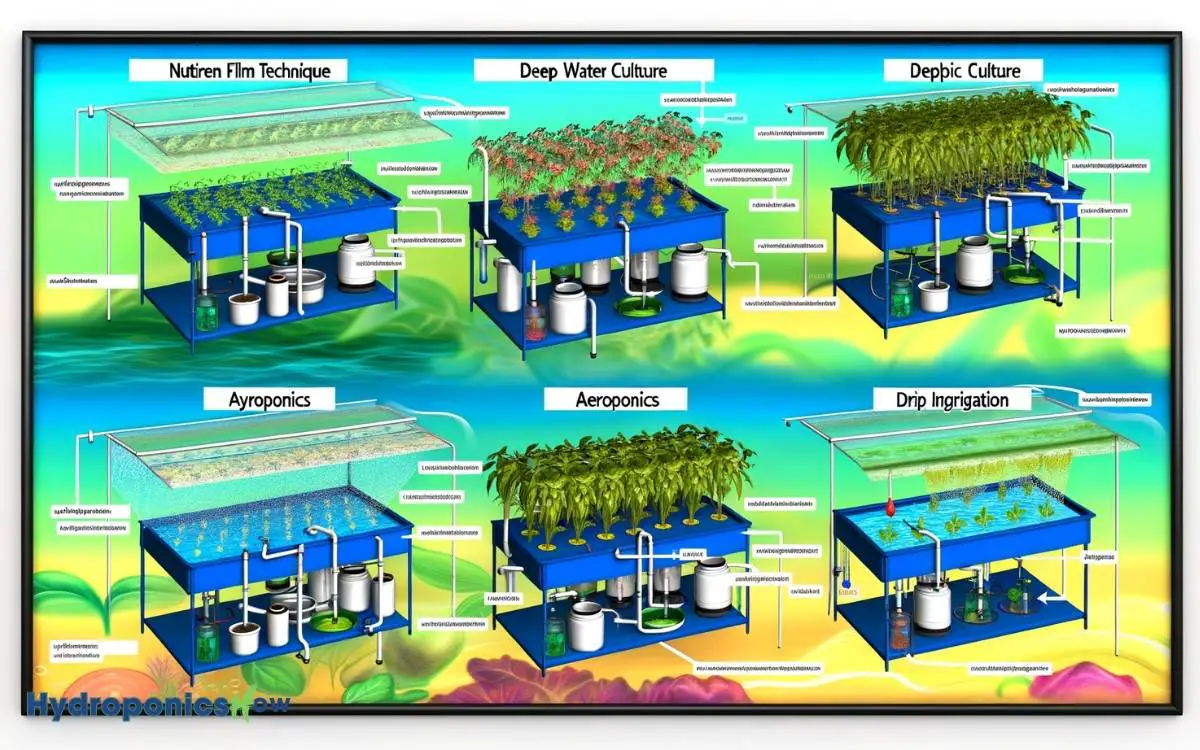
Key Takeaways
Wick Systems
Wick systems represent one of the most fundamental types of hydroponic setups, relying on capillary action to deliver nutrient solutions to plant roots without the use of pumps. This simplicity makes them ideal for beginners and small-scale operations.
The setup typically involves a reservoir containing a nutrient solution and a growing medium, such as perlite or vermiculite, placed above it. Wicks, often made of absorbent materials like cotton or nylon, connect the reservoir to the growing medium.
As the plants uptake nutrients, the wicks continuously draw the solution upwards, maintaining consistent moisture levels.
However, this system is best suited for small, non-demanding plants due to its limited nutrient delivery efficiency and the potential for nutrient imbalances in larger or more nutrient-hungry plants.
Deep Water Culture
Deep Water Culture (DWC) systems are characterized by suspending plant roots directly in a nutrient-rich, oxygenated water solution.
Effective management of this system necessitates precise control of nutrient concentrations and regular monitoring of dissolved oxygen levels.
This method promotes rapid plant growth due to the constant availability of water, nutrients, and oxygen, resulting in enhanced productivity and yield.
Basic System Components
The fundamental components of a Deep Water Culture system include an aeration mechanism, a nutrient reservoir, net pots, and a robust support structure to guarantee ideal plant growth and health.
The aeration mechanism, typically an air pump connected to air stones, ensures adequate oxygenation of the nutrient solution, which is crucial for root respiration.
The nutrient reservoir holds the nutrient-rich solution, providing essential minerals and elements directly to the plant roots.
Net pots, filled with inert growing media, support the plants while allowing roots to extend into the nutrient solution.
Key elements include:
- Aeration Mechanism: Provides oxygen to the roots.
- Nutrient Reservoir: Stores nutrient solution.
- Net Pots and Support Structure: Ensures plant stability and access to nutrients.
This configuration optimizes root oxygenation and nutrient uptake.
Nutrient Solution Management
Effective nutrient solution management in Deep Water Culture systems is vital to guaranteeing ideal nutrient availability and plant health. This involves maintaining ideal pH levels, typically between 5.5 and 6.5, to facilitate nutrient uptake.
Electrical conductivity (EC) should be regularly monitored to ensure nutrient concentration remains within the preferred range, typically 1.2-2.5 mS/cm, depending on plant species.
Oxygenation is paramount; dissolved oxygen levels should be kept above 5 ppm through aeration techniques like air stones.
Regular solution replacement, ideally bi-weekly, prevents nutrient imbalances and pathogen buildup.
Temperature control is also essential, with the nutrient solution ideally maintained between 65-75°F (18-24°C) to optimize metabolic processes.
Adhering to these parameters ensures the robust growth and development of hydroponic crops.
Plant Growth Benefits
In Deep Water Culture (DWC) systems, plants experience accelerated growth rates due to the direct access roots have to nutrient-rich, oxygenated water. This method optimizes the absorption of essential minerals and oxygen, facilitating robust plant development.
Key advantages of DWC systems include:
- Enhanced Nutrient Uptake: Continuous exposure to dissolved nutrients guarantees that plants receive a consistent supply of essential elements.
- Optimal Root Oxygenation: Aeration systems provide ample oxygen to the root zone, preventing hypoxia and promoting vigorous root health.
- Rapid Growth Cycles: The ideal growth conditions provided by DWC systems often result in shorter cultivation periods and higher yields.
These benefits underscore the efficacy of DWC systems in maximizing plant growth and productivity in hydroponic setups.
Nutrient Film Technique
The Nutrient Film Technique (NFT) involves a continuous thin film of nutrient-rich solution flowing over the roots of plants housed in a slightly inclined channel.
This system offers the key advantage of efficient nutrient delivery and oxygenation, enhancing plant growth rates.
However, it also poses challenges such as root matting and the potential for rapid system failure if the nutrient flow is disrupted.
Basic System Overview
Nutrient Film Technique (NFT) is a hydroponic method characterized by a continuous, thin film of nutrient solution that flows over the roots of the plants, providing ideal conditions for nutrient uptake and oxygenation.
This technique utilizes a slightly sloped channel to guarantee the nutrient solution consistently circulates, minimizing stagnation and fostering peak root health.
Key components of an NFT system include:
- Nutrient Reservoir: Holds the nutrient solution and is connected to a pump that circulates the solution through the channels.
- Growth Channels: Sloped channels that house the plant roots, facilitating continuous exposure to the nutrient film.
- Return System: Collects the nutrient solution after it has passed through the channels, returning it to the reservoir for recirculation.
The simplicity and efficiency of NFT make it a popular choice for various crops.
Key Advantages Highlighted
One of the primary advantages of the Nutrient Film Technique (NFT) is its ability to provide a highly efficient and controlled nutrient supply to plant roots, thereby maximizing growth conditions and improving overall plant health.
This system guarantees a thin film of nutrient-rich water flows continuously over the root zone, promoting ideal nutrient absorption and oxygenation.
The constant movement of nutrients prevents stagnation and reduces the risk of root diseases. Additionally, NFT systems are highly scalable and can be easily customized, making them suitable for a wide range of plant species.
Their design also minimizes water usage, as the recirculated nutrient solution maximizes efficiency, contributing to sustainable agricultural practices.
These attributes collectively enhance crop yields and quality.
Common Challenges Faced
Despite its numerous advantages, implementing the Nutrient Film Technique (NFT) presents several technical challenges that can hinder its effectiveness and operational efficiency.
One major issue is the susceptibility to pump failures, which can disrupt nutrient flow and damage plant roots.
Additionally, the system requires precise nutrient management to prevent deficiencies or toxicities due to the continuous, shallow water flow.
Moreover, maintaining an ideal root zone environment is complex, as root diseases can proliferate rapidly under suboptimal conditions.
- Pump reliability: Essential to maintain continuous nutrient flow.
- Nutrient management: Critical to avoid imbalances.
- Root zone environment: Complicated to control, prone to disease.
Addressing these challenges is essential for optimizing NFT systems and ensuring sustainable and high-yield hydroponic operations.
Ebb and Flow
The Ebb and Flow hydroponic system, also known as flood and drain, operates on a cyclical process of flooding the plant roots with a nutrient-rich solution and then allowing it to drain away, thereby promoting ideal oxygenation and nutrient uptake.
This method is highly effective for various crops, allowing for control over nutrient availability and preventing root rot through periodic drying phases.
Below is a table summarizing key aspects:
| Parameter | Details | Benefits |
|---|---|---|
| Operation Cycle | Flood and drain | Enhanced oxygenation |
| Nutrient Delivery | Periodic nutrient-rich solution | Optimized nutrient uptake |
| Root Health | Aeration during drain phase | Reduced risk of root diseases |
| System Setup | Reservoir, pump, and grow bed | Simple and efficient |
| Application | Versatile for various crop types | Increased yield and growth rates |
This system’s adaptability makes it a popular choice in both commercial and hobbyist hydroponics.
Drip Systems
Drip systems, also known as trickle irrigation, utilize a network of tubing to deliver nutrient-rich solutions directly to the base of each plant, ensuring precise and efficient nutrient distribution.
This method is particularly effective in reducing water and nutrient waste. By controlling the flow rate and timing, growers can tailor the nutrient delivery to the specific needs of each plant.
Key advantages of drip systems include:
- Scalability: Ideal for both small-scale and large-scale operations.
- Water Conservation: Minimizes water use by targeting the root zone directly.
- Disease Prevention: Reduces the risk of diseases by keeping foliage dry.
These systems are highly adaptable and can be integrated with automation technologies to further optimize plant growth and resource management.
Aeroponics
Building on the principles of efficient nutrient delivery observed in drip systems, aeroponics offers an advanced method where plant roots are suspended in air and intermittently misted with a nutrient-rich solution, maximizing oxygen exposure and promoting rapid growth.
This system leverages fine mist nozzles to deliver precise amounts of nutrients directly to the root zone, minimizing water usage and eliminating the need for growth medium.
The enhanced oxygenation accelerates metabolic processes, leading to faster nutrient uptake and robust plant development.
Moreover, the absence of soil and substrate greatly reduces the risk of root diseases, making aeroponics a highly efficient and sustainable solution for high-yield, commercial-scale horticulture.
The system’s meticulous control over environmental variables ensures ideal growth conditions.
Aquaponics
Integrating aquaculture with hydroponics, aquaponics creates a symbiotic environment where fish and plants coexist, with fish waste providing a natural nutrient source for plant growth.
Utilizing microbial activity, the system converts ammonia from fish waste into nitrates, which are then absorbed by the plants.
This closed-loop system offers several benefits:
- Efficient Resource Utilization: Aquaponics maximizes water use efficiency, reducing overall consumption by recirculating water between fish tanks and plant beds.
- Enhanced Plant Growth: The continuous supply of organic nutrients from fish waste promotes robust plant development and higher yields.
- Sustainability: By integrating aquaculture and hydroponics, aquaponics reduces reliance on chemical fertilizers and minimizes environmental impact.
This approach exemplifies a holistic method of sustainable food production, leveraging the biological synergy between aquatic and plant life.
Vertical Hydroponics
In vertical hydroponics, plants are cultivated in vertically stacked layers, optimizing spatial efficiency and maximizing crop yield per unit area.
This system employs various media and nutrient solutions to guarantee ideal growth conditions. The vertical design allows for enhanced light exposure and better air circulation, essential for robust plant development.
Below is a comparison of key attributes of vertical hydroponic systems:
| Attribute | Advantage | Consideration |
|---|---|---|
| Space Efficiency | Maximizes use of vertical space | Requires structural support |
| Light Exposure | Enhanced due to tiered design | May need supplemental lighting |
| Water Usage | More efficient, recirculating flow | Potential for uneven distribution |
| Crop Yield | Higher per unit area | Initial cost can be significant |
These attributes make vertical hydroponics an appealing option for urban farming and controlled environment agriculture.
Kratky Method
The Kratky Method is a passive hydroponic technique that utilizes a non-circulating water reservoir to provide nutrients to plants without the need for pumps or complex irrigation systems.
This innovative approach relies on a static nutrient solution where the plant roots are partially submerged. As plants consume nutrients and water, the solution level drops, creating an air gap for root aeration.
Key benefits of the Kratky Method include:
- Simplicity: Requires minimal components and setup, making it accessible.
- Cost-Effectiveness: Eliminates the need for electrical pumps, reducing operational costs.
- Low Maintenance: Once established, the system requires infrequent monitoring and adjustments.
This method is particularly advantageous for small-scale growers seeking an efficient and low-overhead hydroponic solution.
Conclusion
In hydroponic systems, the diverse methodologies – ranging from Wick Systems to the Kratky Method – represent the myriad branches of a growing tree, each technique symbolizing a unique path to nurturing plant life.
This spectrum of systems offers tailored solutions to optimize plant growth, demonstrating the versatility and innovation inherent in soilless agriculture.
As roots seek sustenance from nutrient-rich waters, hydroponics stands as a proof of the boundless potential of modern agricultural practices.

